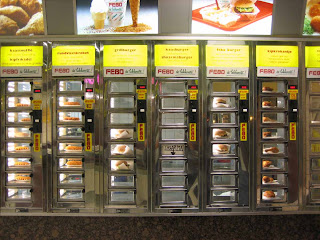One of the things I quickly discovered when I moved to the Netherlands is that the Dutch seem to be addicted to deep-fried food. Examples of savoury Dutch deep-fried delicacies are:
- Bitterballen (round balls containing thick meat sauce)
- Frikandel (a long skinless dark coloured sausage of beef and pork mince)
- Kibbeling (fried fish bits, perceived to be healthy because they’re fish-based!)
- Patat/Patat frites/Vlaamse frites (Belgian fries)
- Rundfleeskroket (oblong shaped croquette containing beef mince)
- Satekroket (similar to the rundfleeskroket, but also containing garlic and peanut butter!)
When I worked at a large office in the Netherlands the only hot food served in the canteen was deep fried, everything else was (of course) bread or cheese. Here, I saw many Dutch colleagues eating deep-fried croquettes mashed up and spread in a bread bun. This seems far from a healthy balanced meal and more like a carb overdose to me. Not being particularly fond of meat slurry, I’ve only dared to eat Bitterballen and Patat. Bitterballen are served with a small ramekin of mustard and Patat (frites) are smothered with mayonnaise. There is a whole fast-food retail concept “FEBO” focusing on just these sorts of vein-cloggers. The name FEBO comes from the street where the first ever shop was located, on the Ferdinand Bolstraat round the corner from where I live in Amsterdam. Now common all over the country, each establishment is nothing more than a couple of guys with deep fryers and a wall with rows of coin-operated vending doors. Behind the doors a range of soggy looking burgers and croquettes await. Drunk Dutch boys will sometimes attempt to eat a “straatje” (street) which means opening a whole row of the little doors of doom and consuming the contents within. Calorie-wise, I’m sure this idea knocks the typical “English” donner kebab into touch, and that was always rumoured to be the equivalent of your daily calorie allowance in one go. As far as I know FEBO is unique to Holland, surprisingly the concept has not been exported.
There is a whole fast-food retail concept “FEBO” focusing on just these sorts of vein-cloggers. The name FEBO comes from the street where the first ever shop was located, on the Ferdinand Bolstraat round the corner from where I live in Amsterdam. Now common all over the country, each establishment is nothing more than a couple of guys with deep fryers and a wall with rows of coin-operated vending doors. Behind the doors a range of soggy looking burgers and croquettes await. Drunk Dutch boys will sometimes attempt to eat a “straatje” (street) which means opening a whole row of the little doors of doom and consuming the contents within. Calorie-wise, I’m sure this idea knocks the typical “English” donner kebab into touch, and that was always rumoured to be the equivalent of your daily calorie allowance in one go. As far as I know FEBO is unique to Holland, surprisingly the concept has not been exported.
Broodje frikandel is basically the Dutch equivalent of a hot dog, but of course the sausage is deep fried instead of boiled. Probably broodje frikandel came long before the hot dog in fact. Anyway, the Dutch are mad for them, as can be seen in this classic Dutch music video: http://www.youtube.com/watch?v=E8wBJlApVFU
The Dutch are very particular about the way of dressing their chips (patats) and you need to be in with their lingo to make a successful order. If you just want salt, ask for “patat zonder”, chips with salt and mayonnaise are “patat met”. You can also get “patatje oorlog” (chip battle) which is the last chips from the pan drenched in pretty much every sauce available (peanut sauce, mayo, curry sauce, ketchup and chopped raw onions). This is probably the only way you’ll be able to get chips with ketchup in Holland without being criticised, but all the other throat burners come with it too. One last treat worth a mention is Oliebollen (literal translation: Oil balls). These sweet deep-fried pastries are similar to donuts, but roughly spherical and with raisins, currants and sultanas added to the batter. They are most delicious when served hot and with powdered sugar on top. Oliebollen are only available to buy at and around New Year, when Oliebollaries (decorated sales huts) appear all around the city wafting the smell of their freshly fried Oliebollen. We’ve made our own fresh Oliebollen on New Years Eve for the past three years in a row, they were really lekker (yummy) but not at all ball-shaped.
One last treat worth a mention is Oliebollen (literal translation: Oil balls). These sweet deep-fried pastries are similar to donuts, but roughly spherical and with raisins, currants and sultanas added to the batter. They are most delicious when served hot and with powdered sugar on top. Oliebollen are only available to buy at and around New Year, when Oliebollaries (decorated sales huts) appear all around the city wafting the smell of their freshly fried Oliebollen. We’ve made our own fresh Oliebollen on New Years Eve for the past three years in a row, they were really lekker (yummy) but not at all ball-shaped.
